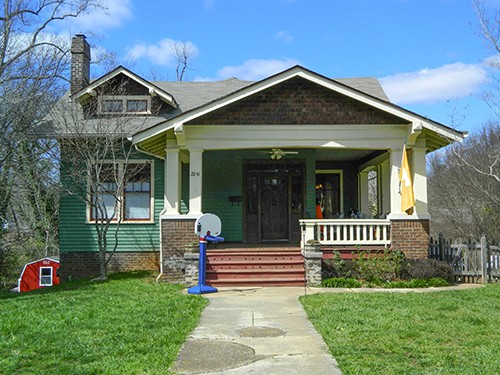William Louis Welcker: Mayor of Old North Knoxville (1849 -1922)
The economic surge that occurred in Knoxville after the Civil War brought about a rapid expansion to the north and west and resulted in a rapid increase in population. To meet the demand for housing, old North Knoxville experienced a boom promoted mainly by Knoxville architects George Barber, Charles Barber and David Getaz. Physicians, railway officials, business managers and public officeholders, including two future Knoxville mayors, Benjamin Morton and George Dempster, would eventually be among its residents.
Impatient while awaiting probable annexation into the city, North Knoxville incorporated on Jan. 16, 1889, and L.A. Gratz was elected its first mayor. Contracts were soon let for water supply, sewage disposal and electric lights. Mynders, a highly-regarded elementary school, was soon established. By 1895, the population had grown to 3,200.
Old North Knoxville was roughly located just off Broadway, bounded by Central Ave. to the south, Woodland Ave. to the northwest, Armstrong Ave. to the east and Bluff St. to the northeast. Straddling a ridge that gradually rises from First Creek and then descends toward Second Creek, its wooded building sites were an attraction for many prominent families.
The Fountain Head Railway (1890-1905) traversed the area and the streetcar lines eventually followed. To further stimulate its growth, several businesses were established along Second Creek, including Brookside Cotton Mill, Fantz Sausage Factory and two marble works.

Judge William L. Welcker (Circa 1900). Photo courtesy of the McClung Historical Collection
It was into this flourishing environment that a progressive leader, William Louis Welcker (1849-1922), was elected mayor. He was born in Poplar Creek in Roane County on Feb. 17, 1849, the son of Charles F. Welcker, a prosperous planter, and the former Caroline Virginia Mitchell.
William finished grade and high school in the community and entered law school at Cumberland University where he received his degree in 1871 with honors. Although he was only 22 years old, his extraordinary acumen was recognized by Gov. John C. Brown and he was appointed district attorney for the Third Judicial Circuit on March 14, 1872, and then elected to a full term in August of that year. His term expired on Sept. 1, 1878.

Judge William L. and Mrs. Welcker. Shown here on the lawn of their Gibbs Drive home, the Welckers took great pride in their house, lawn and gardens. Photo courtesy of Marcus Chady, AIA
On Sept. 17, 1884, Anna L. Crawford of Jonesboro and attorney William L. Welcker were married. They were parents of two children, Charles William (1885-1897), who died as a child, and Annette C. (1889-1980), who became a teacher and later a principal in the Knox County schools.
Welcker entered private practice in Loudon and Roane counties until 1887 when he moved to Knoxville and joined the prominent law firm of Henderson and Jourolmon. The firm acted as legal counsel for the East Tennessee, Virginia and Georgia Railroad and later for its successor, the Southern Railway, along with other prestigious clients.
The Welckers made their home at 825 Luttrell St. in what would become North Knoxville by an act of the state Legislature on Jan. 1, 1889. Capt. William Rule’s “Standard History of Knoxville” records a detailed description of its progress, including the issuance of bonds for the improvement of streets, the establishment of a fire department and other necessary development.
In 1893, William L. Welcker was elected the second mayor and North Knoxville entertained an invitation to unite with the city of Knoxville issued by the Knoxville mayor and board of aldermen. A consolidation committee was appointed with Mayor Welcker chosen as one of the commissioners. After much deliberation and following an act of the Legislature, an election was held to determine the will of the people.
On July 23, 1897, by a vote of 1,179 to 182, the annexation of both North Knoxville and West Knoxville was approved and, effective on Jan. 1, 1898, they were officially annexed to the city of Knoxville.
Pursuant to his lifetime interest in public education, Welcker had concurrently served on the North Knoxville Board of Education from 1891 to 1896. He would later serve on the Knoxville Board of Education from 1907 to 1916.
He was also vice-president of the Peoples Telephone Co. (1894) and the president of the Union Bank (1896). He was one of the oldest Masons in East Tennessee, having joined Union Lodge No. 88 in Kingston early in life and culminating as the Knight Templar of Knoxville’s Couer de Lion commandery late in life. When he moved to Knoxville, Welcker became an active member of the First Cumberland Presbyterian Church and served as a deacon in the church and in several positions on its board.
In 1917, the Welckers moved to historic Gibbs Drive in Fountain City where they pioneered in another Knox County development, the Gibbs-Maloney Addition. Charles Gibbs and Frank Maloney had established that “Streetcar Suburb” only a few years earlier. The suburb was recognized on the National Register of Historic Places in 2000.
When he suffered an attack of pneumonia, William Louis Welcker was admitted to Knoxville General Hospital. He succumbed only two days later on Feb. 6, 1922, survived by his wife of 37 years, Anna C. Welcker (1864-1955), and by his daughter, Annette, who continued to live at 2841 Gibbs Drive for many years. Following services at his home church conducted by the Rev. William H. Butler, he was interred in the family burial plat in Greenwood Cemetery.
The Gibbs Drive Historic District
The registration form for the recognition of the Gibbs Drive Historic District for the National Register of Historic Places was prepared by Cathryn Irwin in August 1999 and approved in 2000.
The form indicates that Gibbs Drive was once known as Jackson Boulevard. The first house on the street predates the subdivision. That house was on the corner of Jacksboro Pike and Jackson (now Gibbs) was built about 1910. Charles Gibbs and Frank Maloney, real estate and property company partners, had the land surveyed and subdivided and recorded their plan on Sept. 16, 1911.
Two bungalows were built in 1913 and, throughout the remainder of that decade, bungalows sprang up in the new Gibbs-Maloney development. Among those houses was the bungalow at 2841 Gibbs built by Judge W.L. Welcker. His family lived there from 1917 to 1981.
The form’s description of the interesting Welcker house is typical of Gibbs Drive architecture and follows: 2841 Gibbs Drive (c 1917) Welcker House. Bungalow with Craftsman influence. One story frame with raised basement and weatherboard wall covering. Side gable roof with façade gable roof dormer, curved knee braces, rafter tails and asphalt shingle roof covering. Six-over-one, paired, double-hung windows. One story, wrap around porch with tripled, square wood columns, Doric capitals, brick piers and sawn wood balustrade. Ten light transoms and four light sidelights at façade entry. Two brick chimneys, one exterior side, one interior offset. Brick foundation. Irregular plan.
Author’s Note: Thanks to the following for assistance with the text and the graphics: Kim Bridges, James Campbell, Marcus Chady, Jesse F. Mayshark and Sally Polhemus.


